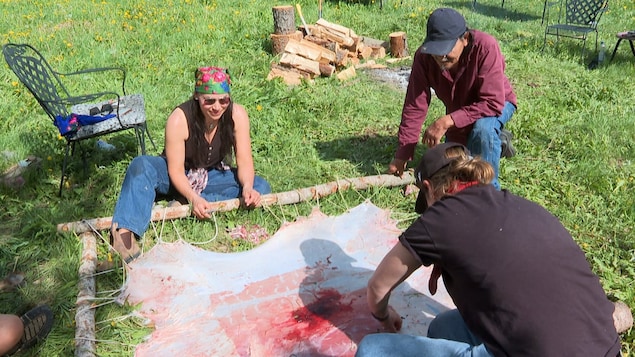The goal, according to its initiators, is to preserve ancestral knowledge and empower students through a traditional curriculum.
The program was founded by Kelly Gordon, an Inuvialuit from the Northwest Territories, while pursuing her business studies at Mount Royal University in Calgary.
She says she wanted to learn more about Indigenous teachings, which prompted her to partner with a family who live at Onespot Crossing, near the Bragg River, west of Calgary.
Classes are open to Indigenous and non-Indigenous students, she explains.
The Tsuut’ina elder, Larry Mistaken Chief, 71, leads the course and passes on this knowledge.
He learned to tan skins by helping his grandmother when he was only nine years old.
Today, he sells his pelts to customers across Canada. He sends them as far north as the Northwest Territories.
I would simply like to pass on my knowledge to a large number of people, because it is a very pleasant activity.
said Larry Mistaken Chief.
Students who took the course had the opportunity to stretch, soak, scrape and dry fresh deer hides.
It’s all natural and all handmade, you know. No machine is involved
said Larry Mistaken Chief.
Reconnect with ancestral traditions
Most of those who take a course to learn from an elder almost always want more, points out Kelly Gordon.
Afterwards, people want to go hunting, people want to build prototypes to scrape knives, people want to learn how to make dry meat. It’s endless.
Kelly Gordon hopes that one day the courses of theAlberta Land Based Education will be accredited by universities.
Calgarian Dakota Davis of the Dene-Cree Nation found out about the course through a Facebook post. His participation exceeded all his expectations.
She claims to have received many subtle teachings throughout the day, simply by observing the elders at work. The whole process was really healthy and beautiful to see
she says.
A source of healing
For Dakota Davis, learning the traditional method of tanning hides was a way of honoring his father, a residential school survivor
she adds.
For Kelly Gordon, reconnecting with ancestral ways has also been a way for her to heal from intergenerational trauma. She says all of her family members were sent to Indian residential schools.
It’s a space where we break the cycles
says Kelly Gordon.
I think we have to get out of there and show the great culture we have. We are a beautiful people, our customs are strong and they have never been stolen, they have always been alive.
Larry Mistaken Chief is pleased that students are interested in learning the traditional method of tanning hides, not only because it can help them understand how their ancestors lived, but also because of the sense of accomplishment that this practice provides.
It’s just something I don’t want to get lost. I don’t want people to forget [comment faire]
he adds.
With files from Kylee Pedersen
Reference-ici.radio-canada.ca
